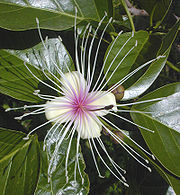Morphology
Flowering plants are heterosporangiate, producing two types of reproductive spores. The pollen (male spores) and ovules (female spores) are produced in different organs, but the typical flower is a bisporangiate strobilus in that it contains both organs.A flower is regarded as a modified stem with shortened internodes and bearing, at its nodes, structures that may be highly modified leaves.[1] In essence, a flower structure forms on a modified shoot or axis with an apical meristem that does not grow continuously (growth is determinate). Flowers may be attached to the plant in a few ways. If the flower has no stem but forms in the axil of a leaf, it is called sessile. When one flower is produced, the stem holding the flower is called a peduncle. If the peduncle ends with groups of flowers, each stem that holds a flower is called a pedicel. The flowering stem forms a terminal end which is called the torus or receptacle. The parts of a flower are arranged in whorls on the torus. The four main parts or whorls (starting from the base of the flower or lowest node and working upwards) are as follows:

An example of a "perfect flower", this Crateva religiosa flower has both stamens (outer ring) and a pistil (center).
- Calyx: the outer whorl of sepals; typically these are green, but are petal-like in some species.
- Corolla: the whorl of petals, which are usually thin, soft and colored to attract animals that help the process of pollination. The coloration may extend into the ultraviolet, which is visible to the compound eyes of insects, but not to the eyes of birds.
- Androecium (from Greek andros oikia: man's house): one or two whorls of stamens, each a filament topped by an anther where pollen is produced. Pollen contains the male gametes.
- Gynoecium (from Greek gynaikos oikia: woman's house): one or more pistils. The female reproductive organ is the carpel: this contains an ovary with ovules (which contain female gametes). A pistil may consist of a number of carpels merged together, in which case there is only one pistil to each flower, or of a single individual carpel (the flower is then called apocarpous). The sticky tip of the pistil, the stigma, is the receptor of pollen. The supportive stalk, the style becomes the pathway for pollen tubes to grow from pollen grains adhering to the stigma, to the ovules, carrying the reproductive material.
In the majority of species individual flowers have both pistils and stamens as described above. These flowers are described by botanists as being perfect, bisexual, or hermaphrodite. However, in some species of plants the flowers are imperfect or unisexual: having only either male (stamens) or female (pistil) parts. In the latter case, if an individual plant is either female or male the species is regarded as dioecious. However, where unisexual male and female flowers appear on the same plant, the species is considered monoecious.
Additional discussions on floral modifications from the basic plan are presented in the articles on each of the basic parts of the flower. In those species that have more than one flower on an axis—so-called composite flowers—the collection of flowers is termed an inflorescence; this term can also refer to the specific arrangements of flowers on a stem. In this regard, care must be exercised in considering what a ‘‘flower’’ is. In botanical terminology, a single daisy or sunflower for example, is not a flower but a flower head—an inflorescence composed of numerous tiny flowers (sometimes called florets). Each of these flowers may be anatomically as described above. Many flowers have a symmetry, if the perianth is bisected through the central axis from any point, symmetrical halves are produced—the flower is called regular or actinomorphic, e.g. rose or trillium. When flowers are bisected and produce only one line that produces symmetrical halves the flower is said to be irregular or zygomorphic. e.g. snapdragon or most orchids.
![Validate my Atom 1.0 feed [Valid Atom 1.0]](valid-atom.png)




0 komentar:
Post a Comment